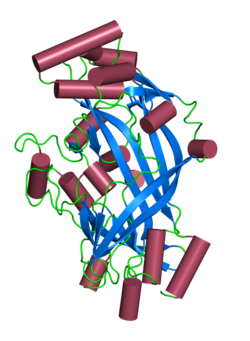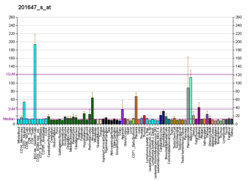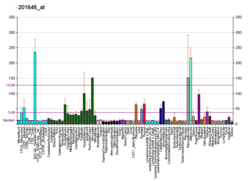SCARB2
Lysosomal integral membrane protein 2 (LIMP-2) is a protein that in humans is encoded by the SCARB2 gene.[5] LIMP-2 is expressed in brain, heart, liver, lung and kidney, mainly in the membrane of lysosome organelles; however, in cardiac muscle, LIMP-2 is also expressed at intercalated discs. LIMP-2 in a membrane protein in lysosomes that functions to regulate lysosomal/endosomal transport. Mutations in LIMP-2 have been shown to cause Gaucher disease, myoclonic epilepsy, and action myoclonus–renal failure syndrome. Abnormal levels of LIMP-2 have also been found in patients with hypertrophic cardiomyopathy.
Structure
Human LIMP-2 has a theoretical molecular weight of 54.3 kDa and is 478 amino acids in length.[6]
Though LIMP-2 was initially discovered in 1985 by Lewis et al. from rat liver lysosomes,[7] LIMP-2 was cloned in 1992 by two groups, one isolated LIMP-2 from human metastatic pancreatic islet tumor cells, and one from rat liver lysosomal membranes.[8][9] LIMP-2 was isolated as a protein of approximate molecular weight 85 kDa, synthesized from a precursor oform of approximately 77 kDa. The weight discrepancy between its theoretical (54.3 kDa) and observed (85 kDa) is due to the presence of 10 high mannose-type N-linked oligosaccharide chains in the human form of this protein, compared to 11 in mouse and rat.[10] LIMP-2 has two hydrophobic regions, one near the N-terminus and one near the C-terminus, as well as a short isoleucine/leucine-rich cytoplasmic tail consisting of 20 amino acids that serves as the lysosomal targeting sequence.[11][12] LIMP-2 has been shown to be expressed in brain, heart, liver, lung and kidney.[10]
Function
The protein encoded by this gene is a type III glycoprotein that is located primarily in limiting membranes of lysosomes and endosomes. Studies of the similar proteins in mice and rat suggested that this protein may participate in membrane transportation and the reorganization of endosomal/lysosomal compartment.[13] In rat hepatic cells, LIMP-2 exhibited a half-life for internalization and lysosomal transport of 32 min and 2.0 h, respectively, which resembled those of well-known lysosomal proteins, lamp-1 and lamp-2, though they have different amino acid sequences in their cytoplasmic tails.[14]
LIMP2 has recently been identified as a novel component of intercalated discs in cardiac muscle. Intercalated discs are composed of gap junctions, adherens junctions and desmosomes, and are critical for the mechanical and electrical coupling of adjacent cardiomyocytes. The discovery of LIMP-2 as a component of this complex came about from a genetic screen of a homozygous, hypertensive transgenic rat model of renin overexpression, in which a population of these rats rapidly develop heart failure and another remains compensated.[15] Out of 143 differentially-regulated genes, LIMP-2 was identified to be significantly upregulated in heart failure-prone rat cardiac muscle biopsies, which also proved true in human heart failure. Further analysis employing a LIMP-2 knockout mouse demonstrated that animals lacking LIMP-2 failed to flight a normal hypertrophic response following angiotensin II treatment, however they developed interstitial fibrosis and dilated cardiomyopathy coordinate with disrupted intercalated disc structure. Biochemical and immunohistochemical analyses discovered that LIMP-2 interacts with N-cadherin at intercalated discs, a function outside of lysosomal membranes. Knockdown of LIMP-2 with RNA interference decreased the binding of N-cadherin to the phosphorylated form of beta-catenin, and LIMP-2 overexpression had the reverse effect.[16]
LIMP-2 plays other roles in other organs. Characteristic tubular proteinuria observed in LIMP-2 knockout mice has been shown to be due to a failure of in lysosomal/endosomal fusion, thus proteins reabsorbed in the proximal tubule of the kidney are not properly proteolyzed, causing the proteinuria.[17] Deficiency of LIMP-2 in mice was also reported to impair cell membrane transport processes and cause pelvic junction obstruction, deafness, and peripheral neuropathy.[18]
Clinical significance
In patients with hypertrophic cardiomyopathy due to aortic stenosis, SCARB2 mRNA is significantly upregulated, suggesting that LIMP-2 may act as a hypertrophic marker.[16]
Mutations in SCARB2 have been shown to cause action myoclonus–renal failure syndrome, a rare syndrome characterized by progressive neurological disease and associated with proteinuria, kidney failure, and focal segmental glomerulosclerosis.[19][20][21]
Mutations in SCARB2 have also been shown to cause Gaucher disease and myoclonic epilepsy,[22] as LIMP-2 is critical for the proper sorting and targeting of glucocerebrosidase enzyme (the enzyme deficient in Gaucher disease) to lysosomes.
SCARB2 is a receptor for two viruses that cause hand, foot, and mouth disease in children, Enterovirus 71 and Coxsackievirus A16.[23]
Interactions
LIMP-2 has been shown to interact with:
References
- ^ a b c GRCh38: Ensembl release 89: ENSG00000138760 – Ensembl, May 2017
- ^ a b c GRCm38: Ensembl release 89: ENSMUSG00000029426 – Ensembl, May 2017
- ^ "Human PubMed Reference:". National Center for Biotechnology Information, U.S. National Library of Medicine.
- ^ "Mouse PubMed Reference:". National Center for Biotechnology Information, U.S. National Library of Medicine.
- ^ "Entrez Gene: SCARB2 scavenger receptor class B, member 2".
- ^ "Protein sequence of human SCARB2 (Uniprot ID: Q14108)". Cardiac Organellar Protein Atlas Knowledgebase (COPaKB). Archived from the original on 14 July 2015. Retrieved 14 July 2015.
- ^ Lewis V, Green SA, Marsh M, Vihko P, Helenius A, Mellman I (Jun 1985). "Glycoproteins of the lysosomal membrane". The Journal of Cell Biology. 100 (6): 1839–47. doi:10.1083/jcb.100.6.1839. PMC 2113609. PMID 3922993.
- ^ Fujita H, Takata Y, Kono A, Tanaka Y, Takahashi T, Himeno M, Kato K (Apr 1992). "Isolation and sequencing of a cDNA clone encoding the 85 kDa human lysosomal sialoglycoprotein (hLGP85) in human metastatic pancreas islet tumor cells". Biochemical and Biophysical Research Communications. 184 (2): 604–11. doi:10.1016/0006-291X(92)90632-U. PMID 1374238.
- ^ Akasaki K, Kinoshita H, Fukuzawa M, Maeda M, Yamaguchi Y, Furuno K, Tsuji H (Jan 1992). "Isolation and characterization of a novel membrane glycoprotein of 85,000 molecular weight from rat liver lysosomes". Chemical & Pharmaceutical Bulletin. 40 (1): 170–3. doi:10.1248/cpb.40.170. PMID 1576668.
- ^ a b Tabuchi N, Akasaki K, Sasaki T, Kanda N, Tsuji H (Oct 1997). "Identification and characterization of a major lysosomal membrane glycoprotein, LGP85/LIMP II in mouse liver". Journal of Biochemistry. 122 (4): 756–63. doi:10.1093/oxfordjournals.jbchem.a021820. PMID 9399579.
- ^ Ogata S, Fukuda M (Feb 1994). "Lysosomal targeting of Limp II membrane glycoprotein requires a novel Leu-Ile motif at a particular position in its cytoplasmic tail". The Journal of Biological Chemistry. 269 (7): 5210–7. doi:10.1016/S0021-9258(17)37676-7. PMID 8106503.
- ^ Sandoval IV, Arredondo JJ, Alcalde J, Gonzalez Noriega A, Vandekerckhove J, Jimenez MA, Rico M (Mar 1994). "The residues Leu(Ile)475-Ile(Leu, Val, Ala)476, contained in the extended carboxyl cytoplasmic tail, are critical for targeting of the resident lysosomal membrane protein LIMP II to lysosomes". The Journal of Biological Chemistry. 269 (9): 6622–31. doi:10.1016/S0021-9258(17)37418-5. PMID 7509809.
- ^ Gonzalez A, Valeiras M, Sidransky E, Tayebi N (Feb 2014). "Lysosomal integral membrane protein-2: a new player in lysosome-related pathology". Molecular Genetics and Metabolism. 111 (2): 84–91. doi:10.1016/j.ymgme.2013.12.005. PMC 3924958. PMID 24389070.
- ^ Akasaki K, Michihara A, Fukuzawa M, Kinoshita H, Tsuji H (Sep 1994). "Cycling of an 85-kDa lysosomal membrane glycoprotein between the cell surface and lysosomes in cultured rat hepatocytes". Journal of Biochemistry. 116 (3): 670–6. PMID 7852289.
- ^ Schroen B, Heymans S, Sharma U, Blankesteijn WM, Pokharel S, Cleutjens JP, Porter JG, Evelo CT, Duisters R, van Leeuwen RE, Janssen BJ, Debets JJ, Smits JF, Daemen MJ, Crijns HJ, Bornstein P, Pinto YM (Sep 2004). "Thrombospondin-2 is essential for myocardial matrix integrity: increased expression identifies failure-prone cardiac hypertrophy". Circulation Research. 95 (5): 515–22. doi:10.1161/01.RES.0000141019.20332.3e. PMID 15284191.
- ^ a b c Schroen B, Leenders JJ, van Erk A, Bertrand AT, van Loon M, van Leeuwen RE, Kubben N, Duisters RF, Schellings MW, Janssen BJ, Debets JJ, Schwake M, Høydal MA, Heymans S, Saftig P, Pinto YM (May 2007). "Lysosomal integral membrane protein 2 is a novel component of the cardiac intercalated disc and vital for load-induced cardiac myocyte hypertrophy". The Journal of Experimental Medicine. 204 (5): 1227–35. doi:10.1084/jem.20070145. PMC 2118572. PMID 17485520.
- ^ Desmond MJ, Lee D, Fraser SA, Katerelos M, Gleich K, Martinello P, Li YQ, Thomas MC, Michelucci R, Cole AJ, Saftig P, Schwake M, Stapleton D, Berkovic SF, Power DA (Jun 2011). "Tubular proteinuria in mice and humans lacking the intrinsic lysosomal protein SCARB2/Limp-2". American Journal of Physiology. Renal Physiology. 300 (6): F1437–47. doi:10.1152/ajprenal.00015.2011. PMID 21429972. S2CID 25993341.
- ^ Gamp AC, Tanaka Y, Lüllmann-Rauch R, Wittke D, D'Hooge R, De Deyn PP, Moser T, Maier H, Hartmann D, Reiss K, Illert AL, von Figura K, Saftig P (Mar 2003). "LIMP-2/LGP85 deficiency causes ureteric pelvic junction obstruction, deafness and peripheral neuropathy in mice". Human Molecular Genetics. 12 (6): 631–46. doi:10.1093/hmg/ddg062. PMID 12620969.
- ^ Balreira A, Gaspar P, Caiola D, Chaves J, Beirão I, Lima JL, Azevedo JE, Miranda MC (Jul 2008). "A nonsense mutation in the LIMP-2 gene associated with progressive myoclonic epilepsy and nephrotic syndrome". Human Molecular Genetics. 17 (14): 2238–43. doi:10.1093/hmg/ddn124. hdl:10400.16/885. PMID 18424452.
- ^ Berkovic SF, Dibbens LM, Oshlack A, Silver JD, Katerelos M, Vears DF, Lüllmann-Rauch R, Blanz J, Zhang KW, Stankovich J, Kalnins RM, Dowling JP, Andermann E, Andermann F, Faldini E, D'Hooge R, Vadlamudi L, Macdonell RA, Hodgson BL, Bayly MA, Savige J, Mulley JC, Smyth GK, Power DA, Saftig P, Bahlo M (Mar 2008). "Array-based gene discovery with three unrelated subjects shows SCARB2/LIMP-2 deficiency causes myoclonus epilepsy and glomerulosclerosis". American Journal of Human Genetics. 82 (3): 673–84. doi:10.1016/j.ajhg.2007.12.019. PMC 2427287. PMID 18308289.
- ^ Hopfner F, Schormair B, Knauf F, Berthele A, Tölle TR, Baron R, Maier C, Treede RD, Binder A, Sommer C, Maihöfner C, Kunz W, Zimprich F, Heemann U, Pfeufer A, Näbauer M, Kääb S, Nowak B, Gieger C, Lichtner P, Trenkwalder C, Oexle K, Winkelmann J (27 October 2011). "Novel SCARB2 mutation in action myoclonus-renal failure syndrome and evaluation of SCARB2 mutations in isolated AMRF features". BMC Neurology. 11: 134. doi:10.1186/1471-2377-11-134. PMC 3222607. PMID 22032306.
- ^ Velayati A, DePaolo J, Gupta N, Choi JH, Moaven N, Westbroek W, Goker-Alpan O, Goldin E, Stubblefield BK, Kolodny E, Tayebi N, Sidransky E (Nov 2011). "A mutation in SCARB2 is a modifier in Gaucher disease". Human Mutation. 32 (11): 1232–8. doi:10.1002/humu.21566. PMC 3196787. PMID 21796727.
- ^ Yamayoshi S, Yamashita Y, Li J, Hanagata N, Minowa T, Takemura T, Koike S (Jul 2009). "Scavenger receptor B2 is a cellular receptor for enterovirus 71". Nature Medicine. 15 (7): 798–801. doi:10.1038/nm.1992. PMID 19543282. S2CID 9192537.
Further reading
- Eskelinen EL, Tanaka Y, Saftig P (Mar 2003). "At the acidic edge: emerging functions for lysosomal membrane proteins". Trends in Cell Biology. 13 (3): 137–45. doi:10.1016/S0962-8924(03)00005-9. PMID 12628346.
- Sandoval IV, Arredondo JJ, Alcalde J, Gonzalez Noriega A, Vandekerckhove J, Jimenez MA, Rico M (Mar 1994). "The residues Leu(Ile)475-Ile(Leu, Val, Ala)476, contained in the extended carboxyl cytoplasmic tail, are critical for targeting of the resident lysosomal membrane protein LIMP II to lysosomes". The Journal of Biological Chemistry. 269 (9): 6622–31. doi:10.1016/S0021-9258(17)37418-5. PMID 7509809.
- Calvo D, Dopazo J, Vega MA (Jan 1995). "The CD36, CLA-1 (CD36L1), and LIMPII (CD36L2) gene family: cellular distribution, chromosomal location, and genetic evolution". Genomics. 25 (1): 100–6. doi:10.1016/0888-7543(95)80114-2. PMID 7539776.
- Crombie R, Silverstein R (Feb 1998). "Lysosomal integral membrane protein II binds thrombospondin-1. Structure-function homology with the cell adhesion molecule CD36 defines a conserved recognition motif". The Journal of Biological Chemistry. 273 (9): 4855–63. doi:10.1074/jbc.273.9.4855. PMID 9478926.
- Harris RA, Yang A, Stein RC, Lucy K, Brusten L, Herath A, Parekh R, Waterfield MD, O'Hare MJ, Neville MA, Page MJ, Zvelebil MJ (Feb 2002). "Cluster analysis of an extensive human breast cancer cell line protein expression map database". Proteomics. 2 (2): 212–23. doi:10.1002/1615-9861(200202)2:2<212::AID-PROT212>3.0.CO;2-H. PMID 11840567. S2CID 44946014.
- Wistow G, Bernstein SL, Wyatt MK, Fariss RN, Behal A, Touchman JW, Bouffard G, Smith D, Peterson K (Jun 2002). "Expressed sequence tag analysis of human RPE/choroid for the NEIBank Project: over 6000 non-redundant transcripts, novel genes and splice variants". Molecular Vision. 8: 205–20. PMID 12107410.
- Kuronita T, Eskelinen EL, Fujita H, Saftig P, Himeno M, Tanaka Y (Nov 2002). "A role for the lysosomal membrane protein LGP85 in the biogenesis and maintenance of endosomal and lysosomal morphology". Journal of Cell Science. 115 (Pt 21): 4117–31. doi:10.1242/jcs.00075. PMID 12356916. S2CID 23366278.
- Rodionov DG, Höning S, Silye A, Kongsvik TL, von Figura K, Bakke O (Dec 2002). "Structural requirements for interactions between leucine-sorting signals and clathrin-associated adaptor protein complex AP3". The Journal of Biological Chemistry. 277 (49): 47436–43. doi:10.1074/jbc.M207149200. PMID 12370188.
- Gamp AC, Tanaka Y, Lüllmann-Rauch R, Wittke D, D'Hooge R, De Deyn PP, Moser T, Maier H, Hartmann D, Reiss K, Illert AL, von Figura K, Saftig P (Mar 2003). "LIMP-2/LGP85 deficiency causes ureteric pelvic junction obstruction, deafness and peripheral neuropathy in mice". Human Molecular Genetics. 12 (6): 631–46. doi:10.1093/hmg/ddg062. PMID 12620969.
- Zhang H, Li XJ, Martin DB, Aebersold R (Jun 2003). "Identification and quantification of N-linked glycoproteins using hydrazide chemistry, stable isotope labeling and mass spectrometry". Nature Biotechnology. 21 (6): 660–6. doi:10.1038/nbt827. PMID 12754519. S2CID 581283.
- Mulcahy JV, Riddell DR, Owen JS (Feb 2004). "Human scavenger receptor class B type II (SR-BII) and cellular cholesterol efflux". The Biochemical Journal. 377 (Pt 3): 741–7. doi:10.1042/BJ20030307. PMC 1223905. PMID 14570588.
- Eckhardt ER, Cai L, Shetty S, Zhao Z, Szanto A, Webb NR, Van der Westhuyzen DR (Feb 2006). "High density lipoprotein endocytosis by scavenger receptor SR-BII is clathrin-dependent and requires a carboxyl-terminal dileucine motif". The Journal of Biological Chemistry. 281 (7): 4348–53. doi:10.1074/jbc.M513154200. hdl:2437/112281. PMID 16368683.
- Gupta SN, Kloster MM, Rodionov DG, Bakke O (Jun 2006). "Re-routing of the invariant chain to the direct sorting pathway by introduction of an AP3-binding motif from LIMP II". European Journal of Cell Biology. 85 (6): 457–67. doi:10.1016/j.ejcb.2006.02.001. PMID 16542748.
- Tserentsoodol N, Gordiyenko NV, Pascual I, Lee JW, Fliesler SJ, Rodriguez IR (2006). "Intraretinal lipid transport is dependent on high density lipoprotein-like particles and class B scavenger receptors". Molecular Vision. 12: 1319–33. PMID 17110915.
- Grove J, Huby T, Stamataki Z, Vanwolleghem T, Meuleman P, Farquhar M, Schwarz A, Moreau M, Owen JS, Leroux-Roels G, Balfe P, McKeating JA (Apr 2007). "Scavenger receptor BI and BII expression levels modulate hepatitis C virus infectivity". Journal of Virology. 81 (7): 3162–9. doi:10.1128/JVI.02356-06. PMC 1866051. PMID 17215280.






